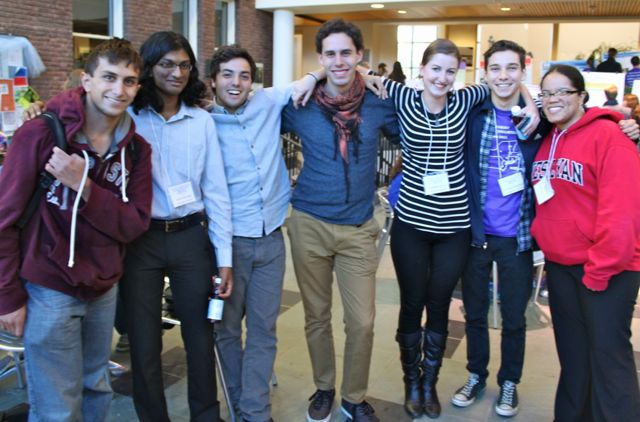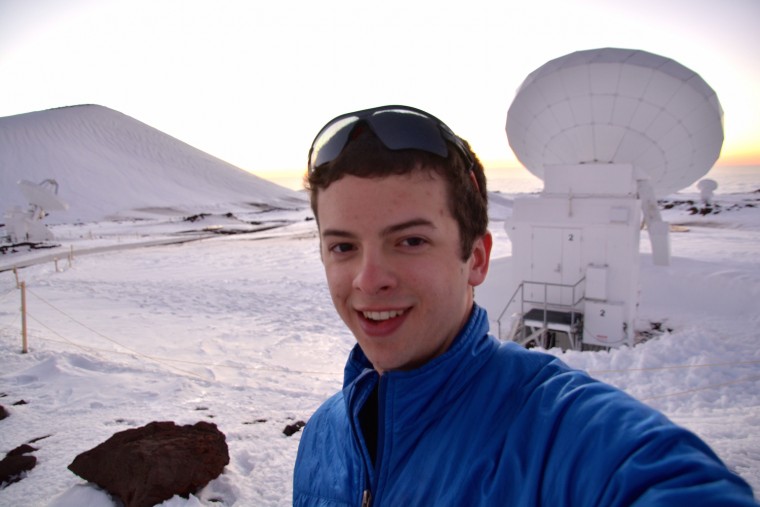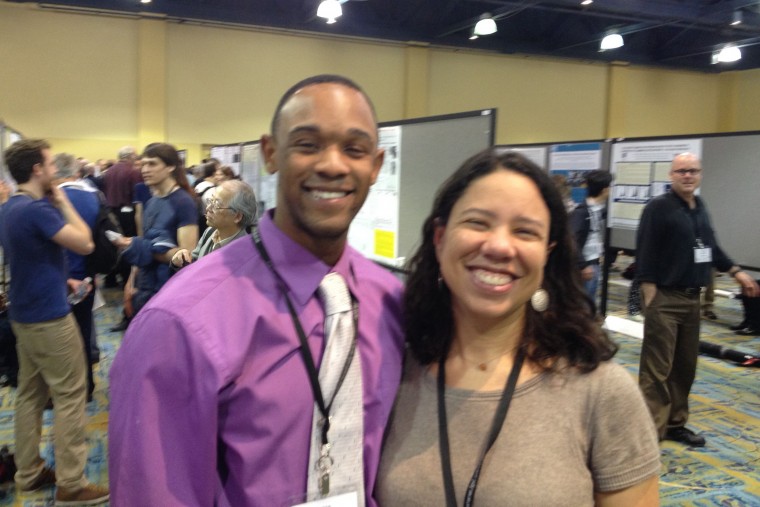Bill Herbst, the John Monroe Van Vleck Professor of Astronomy, and James Greenwood, assistant professor of earth and environmental sciences, co-authored an article published in the planetary science journal Icarus. Their article, “A New Mechanism for Chondrule Formation: Radiative Heating by Hot Planetesimals” grew out of research seminars from the recently introduced Planetary Science graduate concentration and minor at Wesleyan. Their work focused on chondrules, or tiny spheres of molten rock that permeate primitive meteorites and date to very close to the beginning of the solar system. For decades, the existence of chondrules has puzzled astrophysicists and cosmochemists as no…
Kevin Flaherty, a postdoctoral researcher working with Meredith Hughes, assistant professor of astronomy, will speak on "Dusty Debris as a Window into New Planetary Systems" during the American Association for the Advancement of Science's (AAAS) 2016 Annual Meeting in Washington, D.C., Feb. 13. Flaherty is one of three symposium speakers who will discuss the theme "Planet Formation Seen with Radio Eyes." Scientists are now probing how, where, and when planets form and are analyzing the links between planetary system architecture and the properties of the parent circumstellar disk. Though the relationship of planetary to stellar masses remains obscure, it is clear that most…
Four Wesleyan undergraduates and a faculty member received awards in the latest call for proposals from NASA's Connecticut Space Grant Consortium. Astronomy major Rachel Aronow '17 was awarded an Undergraduate Research Fellowship in the amount of $5,000 for her project, "Planet Formation and Stellar Characteristics in Tatooine-like Systems." She is working with Bill Herbst, the John Monroe Van Vleck Professor of Astronomy, studying Tatooine-like systems (named after the fabled home system of Luke Skywalker), which are planet-forming disks that surround a close pair of stars that are in orbit around each other. Aronow conducted research with Herbst last summer, and these funds will support further…
The 26th Annual Undergraduate Research Symposium of the Keck Northeast Astronomy Consortium (KNAC) was held at Williams College on Oct. 17. Five students presented results of their summer research: Julian Dann '17, Aylin Garcia Soto '18, and Girish Duvvuri '17 delivered oral presentations while Rachel Aronow '17 and Avi Stein '17 presented a poster. Several other students came along to enjoy the weekend, which featured a dinner and social event on Friday night, the seminar on Saturday and breakout sessions on such topics as Inclusive Astronomy and how/why to program in Python. More than 100 students and faculty from KNAC attended the event (pictured…
On Sept. 30, NASA’s Discovery Program selected five planetary mission investigations for study during the next year as a first step in choosing one or two missions for launch as early as 2020. Wesleyan’s Martha Gilmore is on two of the investigation teams. Gilmore, the George I. Seney Professor of Geology and chair of the Department of Earth and Environmental Sciences, is an expert on terrestrial planets. She studies the morphology and mineralogy of the surfaces of Venus and Mars using data from orbiting and landed spacecraft. She also is on the Executive Committee of NASA’s Venus Exploration Analysis Group…
For her outstanding contributions to Milky Way research by observational methods, Meredith Hughes, assistant professor of astronomy, received the 2015 Bok Prize in Astronomy from Harvard University. The prize, named in honor of Astronomer Bart Bok (1906–1983), is awarded to a recent holder of a PhD degree in the physical sciences from Harvard or Radcliffe who is under 35 years of age. Hughes received her PhD from Harvard in 2010, and a MA in astronomy from Harvard in 2007. Hughes is an expert on planet formation, circumstellar disk structure and dynamics, gas and dust disk evolution and radio astronomy. She studies planet formation by observing…
Seth Redfield, associate professor of astronomy, and Marshall Johnson '11 are the co-authors of an article titled "The Interstellar Medium in the Kepler Search Volume," published in The Astrophysical Journal, Vol. 802, No. 2, July 2015. The article highlights ways scientists are studying the gas and dust in the galaxy near where the Kepler Space Telescope is discovering exoplanets. "Stars, with planets, can interact with the gas surrounding them in interesting ways, like bubbles in a drink, where each of the bubbles is an individual star (perhaps with planets) and the drink is the 'interstellar medium', the gas in between the stars," Redfield explained. In…
Seth Redfield, associate professor of astronomy, and Wilson Cauley, postdoctoral researcher in astronomy, led the effort on a paper titled "Optical hydrogen absorption consistent with a thin bow shock leading the hot Jupiter HD 189733b" accepted for publication in The Astrophysical Journal. Bow shocks are ubiquitous astrophysical phenomena resulting from the supersonic passage of an object through a gas. In this paper, the authors present a robust detection of a time-resolved pre-transit, as well as in-transit, absorption signature around the hot Jupiter exoplanet HD 189733b using high spectral resolution observations of several hydrogen lines. Better knowledge of exoplanet magnetic field strengths is…
#THISISWHY In this News @ Wesleyan story, we speak with Sam Factor '14, a graduate student in astronomy. Q: Sam, congratulations on completing your master’s thesis in astronomy! We understand you took your first astronomy class in the fall of your senior year at Wesleyan. What was your undergraduate major and how did your late-developing interest in astronomy come about? A: Thank you very much! As an undergrad, I majored in physics and computer science. During the fall of my senior year I took Introductory Astronomy (ASTR 155). I signed up for the course mainly because I wanted an interesting and relatively easy…
On April 29, Sara Seager, Class of 1941 Professor of Planetary Science and Physics at the Massachusetts Institute of Technology, spoke on "The Search for Earth 2.0" at the annual Sturm Memorial Lecture. (Photos by Dat Vu '15) (more…)
Several Wesleyan students and faculty were recently awarded grants for research by NASA's Connecticut Space Grant Program. Seth Redfield, associate professor of astronomy and campus director of NASA's CT Space Grant Consortium, was excited about the number of winners. "I was thrilled to see how successful Wesleyan was this year in getting grants through NASA's CT Space Grant program," wrote Redfield. "It demonstrates the diversity and quality of work we do that is aligned with NASA’s mission." "The grants this year support undergraduate, graduate, and faculty research, as well as special events organized by faculty at Wesleyan to promote exposure and…
Students, faculty and alumni involved in planetary science attended the 46th Lunar and Planetary Science Conference March 16-20 in Houston, Texas. Jim Greenwood, assistant professor earth and environmental sciences, gave a talk titled "urCl-KREEP? Cl-rich glasses in KREEP basalts 15382 and 15386 and their implications for lunar geochemistry." Martha Gilmore, chair and professor of earth and environmental sciences and the George I. Seney Professor of Geology, met with the Venus Exploration Analysis Group as a member of its Executive Committee. Jack Singer '15 and Lisa Korn MA '15 presented posters. Several Wesleyan alumni also made presentations at the conference including James Dottin ’13 (E&ES), now a PhD…






